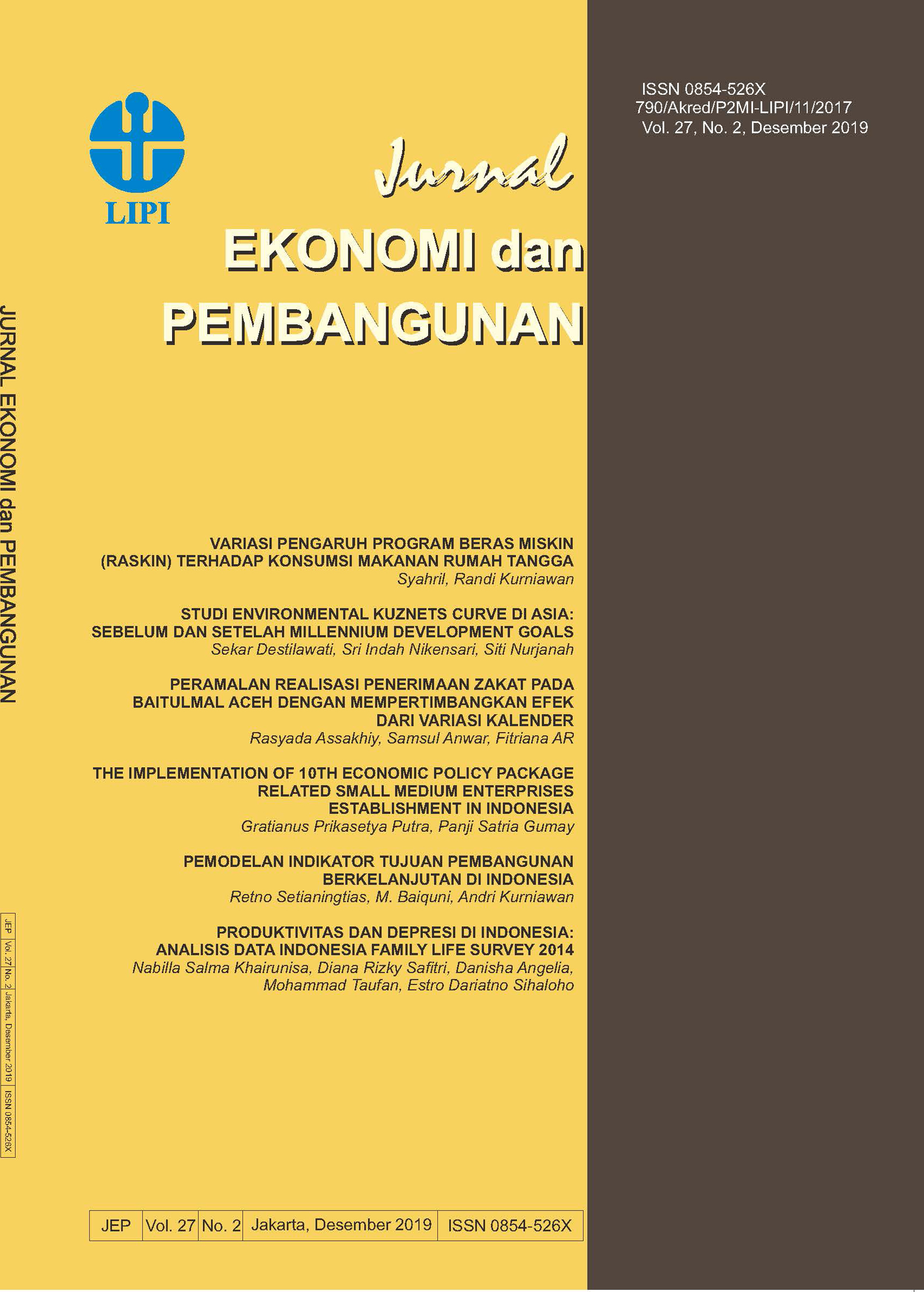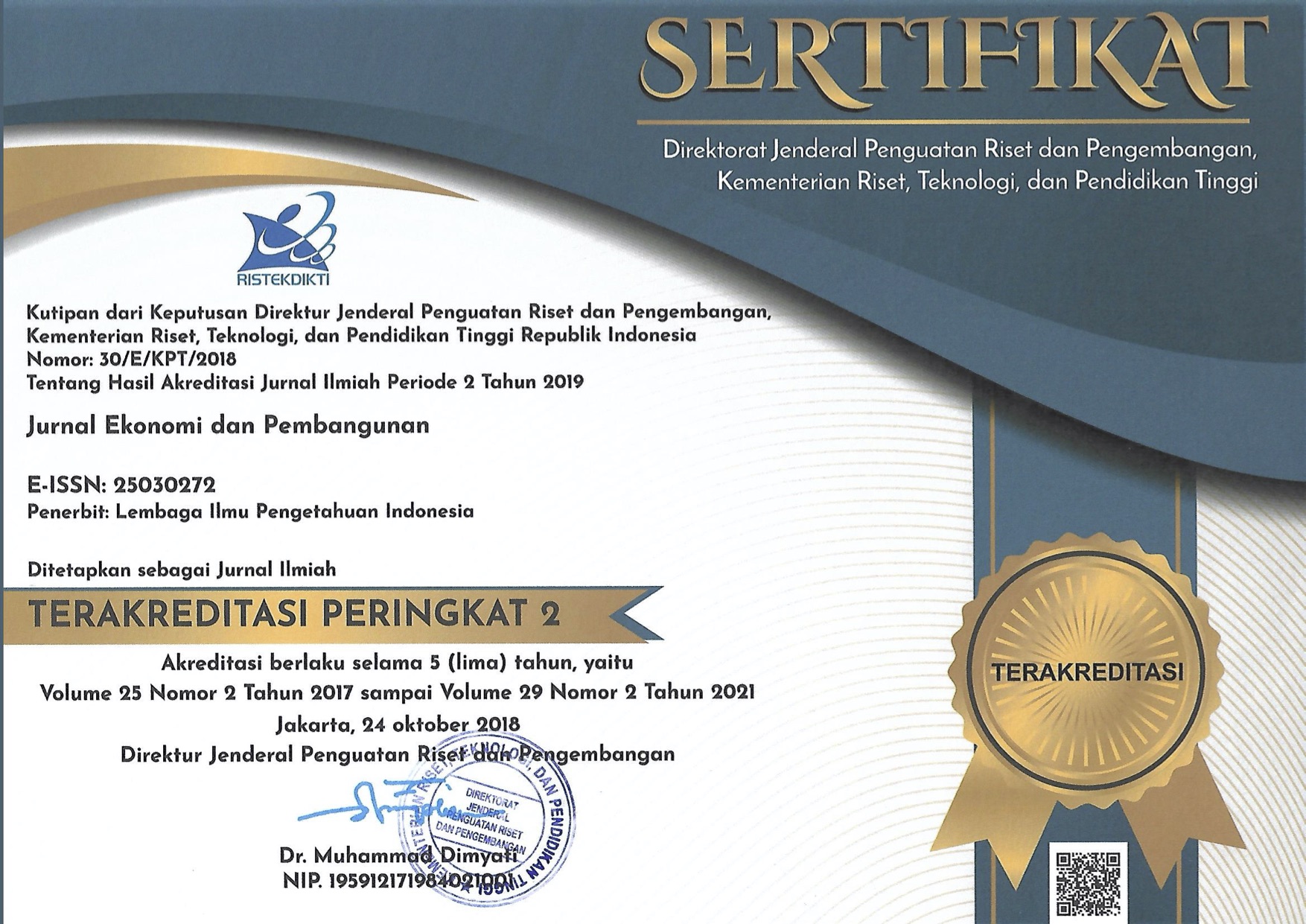STUDI ENVIRONMENTAL KUZNETS CURVE DI ASIA: SEBELUM DAN SETELAH MILLENNIUM DEVELOPMENT GOALS
Abstract
Pencemaran lingkungan dapat menurunkan kesejahteraan subyektif (subjective well-being). Studi ini bertujuan membuktikan berlakunya hipotesis Environmental Kuznets Curve (EKC) di negara-negara berpendapatan tinggi dan menengah Asia, juga untuk menganalisis perbedaan pengaruh GDP per kapita, konsumsi energi, dan populasi penduduk pada emisi CO2 di wilayah yang sama pada periode sebelum dan setelah MDGs. Data diperoleh dari World Bank dengan periode waktu 1987-2014, di mana analisisnya menggunakan metode kuantitatif dan expose facto, dan melalui persamaan regresi data panel guna mencapai tujuan penelitian. Hasil penelitian membuktikan bahwa sampai 2014 hipotesis EKC yang berbentuk U-terbalik belum terjadi di negara-negara high income yang diteliti, namun akan terjadi ketika GDP per kapita sudah mencapai USD 51.44 ribu. Sedangkan di negara-negara lower middle income, pola hubungan antara GDP per kapita dan emisi CO2 masih membentuk kurva U, atau dengan kata lain hipotesis EKC belum akan terjadi di negara-negara ini, karena di beberapa negara tersebut masih dalam tahap awal pembangunan. Hasil penelitian juga menunjukkan bahwa sebelum MDGs (tahun 2000), GDP per kapita, konsumsi energi dan jumlah penduduk di negara-negara high income berkontribusi atas naiknya emisi CO2, namun pasca MDGs ditetapkan, meningkatnya GDP per kapita mampu menurunkan emisi CO2. Sedangkan di negara-negara low middle income, di awal penelitian sebelum MDGs, data menunjukkan bahwa CO2 sudah tinggi pada saat GDP per kapita masih rendah, dan pasca MDGs, kenaikan GDP per kapita masih berkontribusi atas meningkatnya emisi CO2.
Downloads
References
DAFTAR PUSTAKA
Abdurahman, D. A. (2012). Dampak pertumbuhan dan keterbukaan ekonomi terhadap degradasi lingkungan. Departemen Ilmu Ekonomi Fakultas Ekonomi Dan Manajemen Institut Pertanian Bogor, 1–142.
Ali, A., Khatoon, S., Ather, M., & Akhtar, N. (2015). Modeling Energy Consumption , Carbon Emission and Economic Growth : Empirical Analysis for Pakistan. International Journal of Energy Economics and Policy, 5(2), 624–630.
Beck, K. A., & Joshi, P. (2015). An Analysis of the Environmental Kuznets Curve for Carbon Dioxide Emissions: Evidence for OECD and Non-OECD Countries. European Journal of Sustainable Development, 4(3), 33–45. https://doi.org/10.14207/ejsd.2015.v4n3p33
Beckerman, W. (1992). Economic growth and the environment: Whose growth? whose environment? World Development, 20(4), 481–496. https://doi.org/10.1016/0305-750X(92)90038-W
Dasgupta, S., Laplante, B., Wang, H., & Wheeler, D. (2002). Confronting the Environmental Kuznets Curve. Journal of Economic Perspectives, 16(1), 147–168. https://doi.org/10.1257/0895330027157
Endeg, T. W. (2015). Economic growth and environmental degradation in Ethiopia: An environmental Kuznets curve analysis approach. Journal of Economics and International Finance, 7(4), 72–79. https://doi.org/10.5897/JEIF2015.0660
Galeotti, M. (2007). Economic growth and the quality of the environment: Taking stock. Environment, Development and Sustainability, 9(4), 427–454. https://doi.org/10.1007/s10668-006-9030-y
Grossman, G. M., & Krueger, A. B. (1995). Economic Growth and the Environment. The Quarterly Journal of Economics, 110(2), 353–377. https://doi.org/10.2307/2118443
Gujarati, D. (2010). Dasar-Dasar Ekonometrika. Jakarta: Salemba Empat.
Halkos, G. (2009). Environment and Sustainable Development. International Journal of Global Environmental Issues, (17), 111–116.
Harris, J. M. (2002). Environmental and Natural Resource Economics: A Contemporary Approach. Boston: Houghton Mifflin Co.
Kementerian Negara Lingkungan Hidup. (2009). Bahan Ajar Pelatihan Penilaian AMDAL.
Kuswantoro, D. P. (2009). Pembangunan Ekonomi dan Deforestasi Hutan Tropis.
Lean, H. H., & Smyth, R. (2010). CO2emissions, electricity consumption and output in ASEAN. Applied Energy, 87(6), 1858–1864. https://doi.org/10.1016/j.apenergy.2010.02.003
Maryam, J., Mittal, A., & Sharma, V. (2017). CO2 Emissions, Energy Consumption and Economic Growth in BRICS:An Empirical Analysis. IOSR Journal of Humanities and Social Science, 22(2), 53–58. https://doi.org/10.9790/0837-2202055358
Mrabet, A., Achairi, R., & Ellouze, A. (2014). The Two-Way relationship between Economic Growth and CO2 Emissions. 2(6), 32–35.
OECD. (2015). Survey Ekonomi OECD Indonesia.
Panayotou, T. (1993). Empirical Test and Policy Analysis of Environmental Degradation at Different Stages of Economic Development. In WORLD EMPLOYMENT PROGRAMME RESEARCH. https://doi.org/http://sci-hub.tw/http://www.ilo.org/public/libdoc/ilo/1993/93B09_31_engl.pdf
Pao, H. T., & Tsai, C. M. (2011). Modeling and forecasting the CO2 emissions, energy consumption, and economic growth in Brazil. Energy, 36(5), 2450–2458. https://doi.org/10.1016/j.energy.2011.01.032
Phimphanthavong, H. (2013). The Impacts of Economic Growth on Environmental Conditions in Laos. 4(5), 766–774.
Pratama, M. I. A. (2016). Hipotesis Environmental Kuznets Curve di Indonesia Tahun 1960-2013. Universitas Diponogoro.
Shaharir, b. M. Z., & Alinor, M. b. A. K. (2013). The Need for a New Definition of Sustainability. Journal of Indonesian Economy and Business, 28(2), 251–268. https://doi.org/10.1007/978-94-007-2285-9
Suparmoko, M. (2000). Ekonomi Sumber Daya Alam dan Lingkungan. Yogyakarta: BPFE.
Susanti, E. D. (2018). Environmental Kuznet Curve: Hubungan Pertumbuhan Ekonomi dengan Degradasi Kualitas Udara Dalam Pencapaian MilleniumDevelopment Goals (MDGs) di Indonesia. Universitas Negeri Yogyakarta.
UNFCC. (2007). Sekilas Tentang Perubahan Iklim. Retrieved from http://unfccc.int/files/meetings/cop_13/press/application/pdf/sekilas_tentang_perubahan_iklim.pdf.
United Nation. (2007). Perkembangan Pencapaian MDGs Indonesia. Jakarta.
WEF. (2017). Global Shapers Survey. Global Shapers Community. Retrieved from http://www.shaperssurvey2017.org/static/data/WEF_GSC_Annual_Survey_2017.pdf
WMO. (2017). WMO Statement on The State of The Global Climate in 2017. Retrieved from https://library.wmo.int/doc_num.php?explnum_id=4453
World Resource Institute. (2016). Rising To The Challenge.
Zhu, Q., & Peng, X. (2012). The impacts of population change on carbon emissions in China during 1978-2008. Environmental Impact Assessment Review, 36, 1–8. https://doi.org/10.1016/j.eiar.2012.03.003
Copyright (c) 2019 Jurnal Ekonomi dan Pembangunan

This work is licensed under a Creative Commons Attribution-NonCommercial-ShareAlike 4.0 International License.
Terms and Conditions of Publication
1. Author's Rights and Authorities
As an author, you (or your employer or institution) may do the following:
-
make copies (print or electronic) of the article for your own personal use (not for commercial purpose), including for your own classroom teaching use;
-
make copies and distribute such copies (including through email) of the article to research colleagues, but not allowed to distribute commercially and systematically, e.g. via an email list or list server;
-
present the article at a meeting or conference and to distribute copies of the article to the delegates attending such meeting;
-
retain all proprietary rights in any process, procedure, or article of manufacture described in the work;
-
include the article in full or in part in a thesis or dissertation;
-
use the article or any part thereof in a printed compilation of your works, such as collected writings or lecture notes, and other derivative works, with full acknowledgement to JEP as the original journal publishing the article;
-
may reproduce material extracted from the article or derivative works for the author's personal use, but must consider the copyrights procedure.
All copies, print or electronic, or other use of the paper or article must include the appropriate bibliographic citation for the article’s publication in the journal.
2. Requests from Third Parties
Although authors are permitted to re-use all or portions of the article in other works, this does not include granting third-party requests for reprinting, republishing, or other types of re-use. Requests for all uses not included above, including the authorization of third parties to reproduce or otherwise use all or part of the article (including figures and tables), should be referred to P2E-LIPI by going to our website at http://ekonomi.lipi.go.id/.
3. P2E LIPI Copyright Ownership
Economic Research Center, the Indonesian Institute of Sciences (P2E-LIPI) owns the copyrights to reproduce, distribute, disseminate, translate, and other uses in accordance with the existing Laws and Regulations.
Every accepted manuscript should be accompanied by "Copyright Transfer Agreement" prior to the article publication.

This work is licensed under a Creative Commons Attribution-NonCommercial 4.0 International License.
JEP Journal by P2E-LIPI is licensed under a Creative Commons Attribution-NonCommercial-ShareAlike 4.0 International License. Permissions beyond the scope of this license may be available at http://jurnalekonomi.lipi.go.id/index.php/JEP
If you are a nonprofit or charitable organization, your use of an NC-licensed work could still run afoul of the NC restriction, and if you are a for-profit entity, your use of an NC-licensed work does not necessarily mean you have violated the term.






